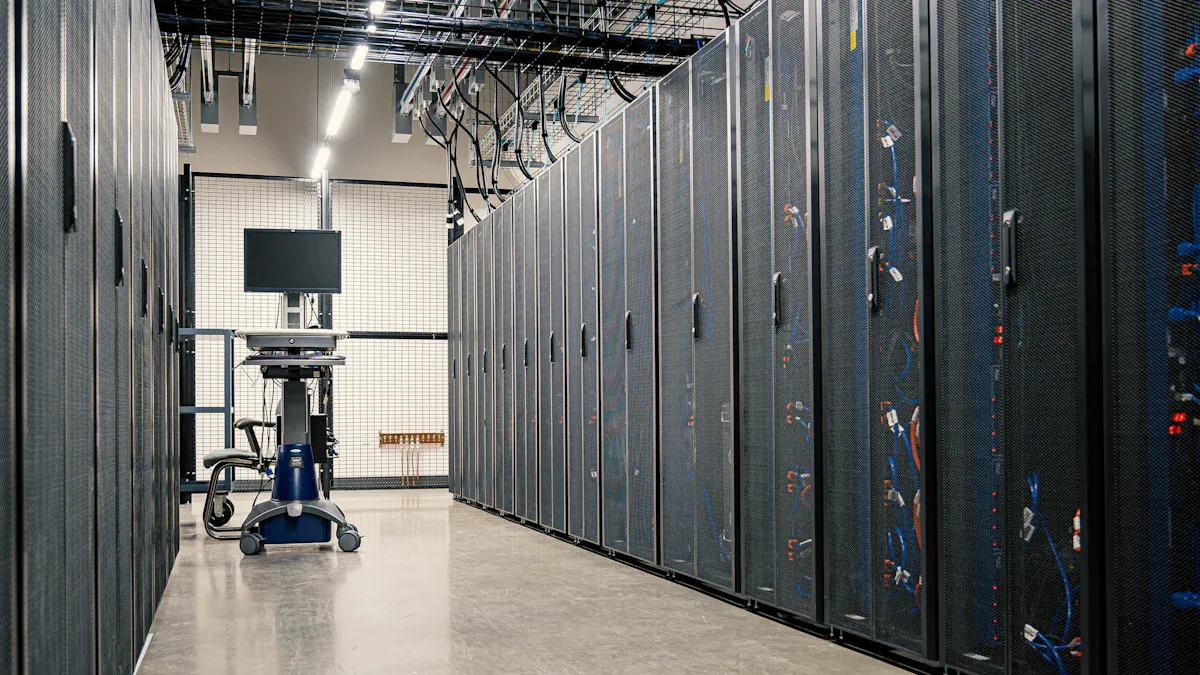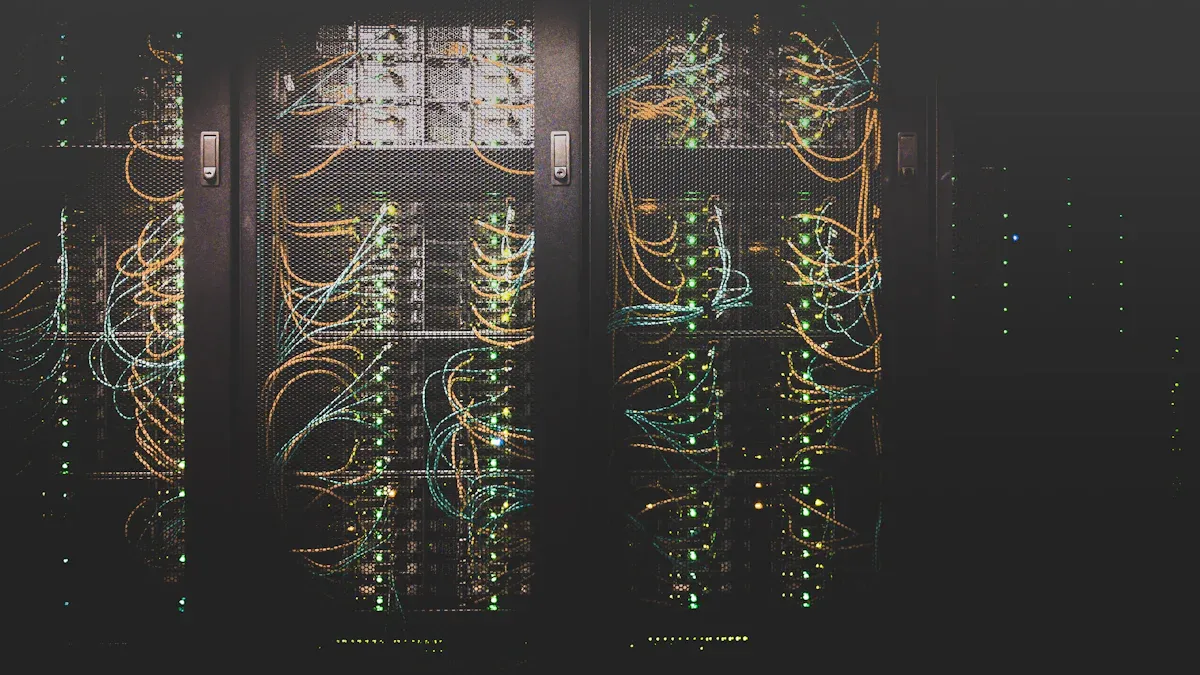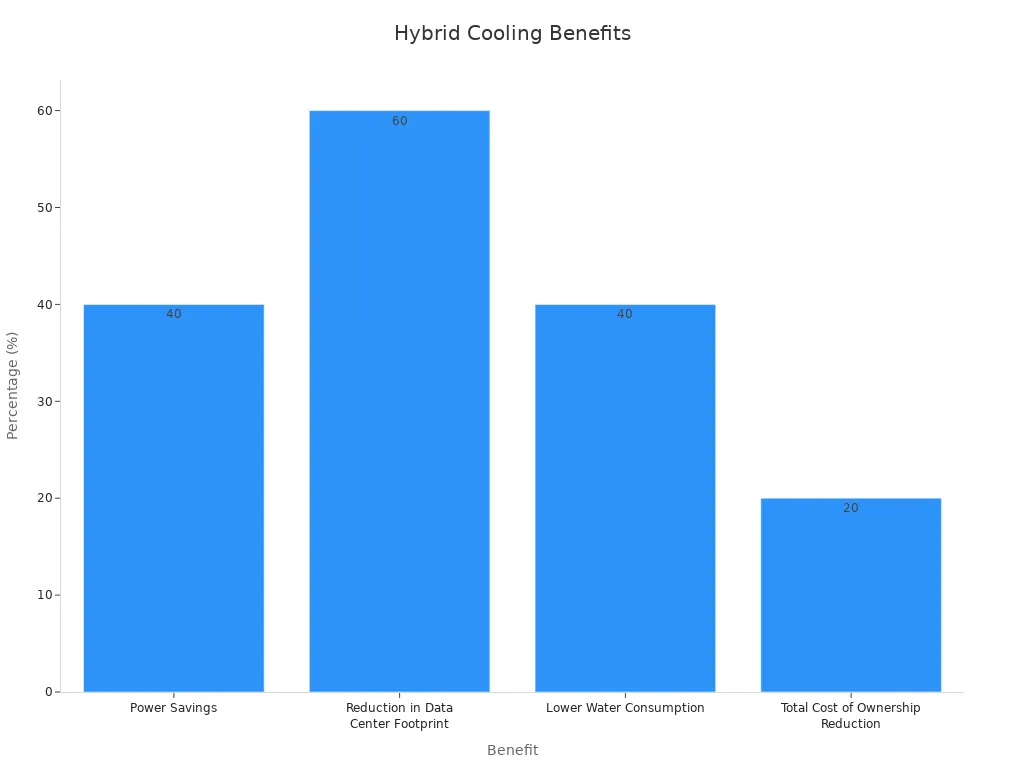Cool Containment: Steps for Data Center Success

Keeping data centers cool through effective Data Center Cooling strategies helps systems work well. It lowers energy bills, boosts reliability, and supports long-term success. Experts predict the Global Data Center Liquid Cooling Market will grow 33.2% yearly until 2032, reaching USD 21.14 billion. Liquid cooling is great for powerful computers.
Liquid cooling is flexible and efficient but costs more to install.
Hybrid cooling, which incorporates both air and liquid, saves money and causes less trouble.
Choosing the best Data Center Cooling plan protects your data center’s future.
Key Takeaways
Check how well your data center cools often. Find problems early. Use heat cameras to see hot spots and fix airflow.
Set up hot and cold aisles to keep air separate. This helps cool better and saves money on energy.
Switch to cooling units that save energy and are smart. These units cut energy costs and help the environment.
Think about using liquid cooling for powerful systems. It works better than air cooling and gets your center ready for new tech.
Use AI and automation to adjust cooling as workloads change. This saves energy and keeps machines working well.
Check How Well Cooling Works Now
Knowing how your data center cools is the first step to making it better. By checking your current setup, you can find problems, save energy, and make systems more reliable. Here’s how to begin:
Do a Heat Check
A heat check shows where cooling might not work well. Use heat cameras to find hot spots and uneven temperatures in your data center. These cameras help you see how air moves and spot blocks. For example, racks in bad spots or vents that are blocked can stop air from flowing. Fixing these problems helps your cooling system work better.
Tip: Check for heat problems often to avoid big issues later. This way, you can keep your equipment running longer and avoid downtime.
Look at Energy Use
Watching energy use shows how much power cooling takes compared to other parts. Data centers use 2.7% of Europe’s electricity now, and this may grow to 3.21% by 2030. Cooling uses a lot of this energy. Switching to better ways, like liquid cooling, can save energy. Liquid cooling works better than air cooling, making it a good choice for today’s data centers.
What It Shows | Number | Year |
|---|---|---|
Data centers’ share of Europe’s electricity use now | 2.7% | Now |
Data centers’ share of Europe’s electricity use later | 3.21% | 2030 |
Energy efficiency of cooling methods | Liquid cooling saves more energy than air cooling | N/A |
Tracking energy use also helps you set goals to improve. Use this info to see how upgrades or changes help your cooling system.
Learn About Cooling Capacity Factor (CCF)
The Cooling Capacity Factor (CCF) shows how well your cooling handles heat from IT equipment. A high CCF means your cooling works well. To find CCF, divide total cooling power by IT load. For example, if cooling power is 500 kW and IT load is 400 kW, the CCF is 1.25. Try for a CCF near 1.0, which means cooling is balanced and not too much.
Studies show better cooling improves performance. For example:
A 2.2 °C temperature difference was found in a battery cross-section.
At 5 °C cold plate temperature, the battery pack's top temperature was 18.3 °C.
Faster discharge rates caused uneven cooling and higher temperatures.
These examples show why even cooling is key to stopping overheating and keeping things working well.
By doing heat checks, watching energy use, and learning about CCF, you can make your data center cooling better. These steps save energy and get your center ready for future needs.
Manage Airflow Effectively
Good airflow management helps your data center stay cool. It lowers energy use, stops overheating, and makes equipment last longer. Follow these three steps to improve airflow:
Arrange Racks Smartly
Where you put server racks affects how air moves. Place racks so cool air reaches the front and hot air moves away. Don’t put racks too close to walls or objects. This blocks air and creates hot spots. Use blanking panels to cover empty spaces in racks. This stops air from circling back. Small changes like this keep temperatures steady.
Tip: Check your rack setup often. Make sure it helps airflow as your data center changes.
Separate Hot and Cold Air
Keeping hot and cold air apart improves cooling. Use a hot aisle/cold aisle setup. Line up racks so fronts face each other in the cold aisle. Backs should face each other in the hot aisle. This setup sends cool air to equipment and pushes hot air out. It stops hot and cool air from mixing. This makes cooling systems work better and saves energy.
Keep Air Clean
Clean air is important for protecting your equipment. Dust and dirt can block airflow and cause overheating. Over time, this can break equipment and cause downtime. Use good air filters and clean them often. A clean space keeps your equipment safe and helps cooling systems work well.
By following these airflow tips, your data center will cool better. This creates a more reliable and energy-saving setup.
Upgrade Cooling Equipment
Improving your cooling equipment can make it work better and cost less. Newer systems perform well and use less energy. Here’s how to upgrade your data center’s cooling.
Get Energy-Saving Cooling Units
Energy-saving cooling units work well while using less power. They have smart features like adjustable fans and controls that match cooling to needs. Upgrading to these units can cut energy bills and help the environment. For instance, swapping old units for energy-saving ones can lower energy use by 30%. This saves money and supports eco-friendly goals.
Tip: Choose cooling units with ENERGY STAR labels for top efficiency and dependability.
Use Free Cooling Methods
Free cooling uses nature to save energy. Techniques like air-side economization and water evaporation cool your data center without heavy equipment. These methods reduce the need for traditional cooling systems. The table below shows how much money free cooling can save:
Method | Energy Cost Savings |
|---|---|
Adiabatic Cooling | |
Free-Cooling Systems | Eliminates chiller costs |
Hybrid Systems | Lowers running costs by 40% |
Using these methods can save a lot of money while keeping your data center cool.
Try Liquid Cooling Systems
Liquid cooling is great for handling heat from modern equipment. These systems use liquids, which cool better than air, to remove heat. Liquid cooling works well for powerful computers and AI tasks. The table below shows how liquid cooling is growing in use:
Evidence Type | Details |
|---|---|
Investment Trends | |
Operational Shift | Liquid cooling is now a key strategy, not just a test. |
Industry Adoption | Big companies are adding liquid cooling to their future plans. |
Switching to liquid cooling prepares your data center for advanced technology. It’s a smart way to boost efficiency and reliability.
By upgrading your cooling with these ideas, you can improve performance and save money.
Explore Advanced Cooling Strategies

Advanced cooling methods can make your data center better. They use less energy, save money, and improve how systems work. Here’s how to use them well.
Use Hybrid Cooling Systems
Hybrid cooling mixes air and liquid cooling for better results. These systems adjust to different workloads to save energy. They can cut power use by 40% and water use by 40%. They also take up 60% less space, which is great for small areas.
Benefit | Measurement |
|---|---|
Power Savings | Up to 40% |
Reduction in Data Center Footprint | 60% reduction |
Lower Water Consumption | Up to 40% |
Total Cost of Ownership Reduction | Around 20% |

Adding hybrid cooling systems saves money and helps the environment.
Try Smart Water Management Systems
Smart water systems help control water use in cooling. They check and adjust water flow using real-time data. This stops waste and makes cooling more efficient. For example, adiabatic cooling can cut water use by 90%. This saves money and helps protect the planet.
Tip: Check your water systems often. This keeps them working well and avoids wasting water.
Plan for Better Airflow
Good airflow design keeps cooling steady. Rules like ASHRAE 90.4 focus on energy needs for data centers. Hot aisle/cold aisle setups stop hotspots and save power. Letting higher temperatures in white spaces can also save energy.
Aspect | Description |
|---|---|
Standard | |
Containment | Keeps air even to stop hotspots and lower power use. |
Temperature Regulation | Allows higher temperatures in white spaces to save energy. |
Planning airflow well improves cooling and cuts energy costs.
Watch and Automate Cooling Systems
Watching and automating cooling systems can change how your data center works. These methods make cooling better, cut costs, and keep things running smoothly. Using live tools, AI solutions, and workload-based automation helps you handle cooling problems easily.
Use Live Monitoring Tools
Live monitoring tools show how your cooling system is doing right now. They check temperature, humidity, and airflow in your data center. These tools find problems and stop equipment from breaking. For example, sensors near servers can find hot spots and warn you to fix them.
Tip: Pick tools that work with your current setup. This makes it easy to collect and study data.
Live monitoring also shows how changes help. If you move air better or get new equipment, these tools show the results. This way, you know every change makes cooling better.
Try AI-Powered Cooling
AI cooling uses smart learning to improve your system. It studies sensor data and guesses cooling needs based on patterns. This saves energy and keeps equipment at safe temperatures.
Some companies already use AI cooling:
Company | What They Did |
|---|---|
Used advanced tools for live system tracking. | |
Virgin Media O2 | Saved over £1M on cooling energy. |
Three | Cut cooling energy by 12.5% in four sites in ten weeks. |
Polar and Vertiv | Added a modular AI system in their Norway data center. |
These examples show how AI saves energy and improves systems. Adding AI cooling can bring similar benefits to your data center.
Automate Cooling for Workloads
Automation changes cooling as workloads rise or fall. When servers work harder, they get hotter. Automated systems cool those areas more. This stops overheating and uses energy wisely.
For example, automation can focus cooling on busy racks during peak times. When work slows, it lowers cooling to save energy. This saves money and helps your equipment last longer.
Note: Check workload trends often to adjust automation settings. This keeps your system ready for changes.
By mixing live monitoring, AI, and automation, you can build a smarter cooling system. These ideas help your data center handle new challenges while saving energy.
Making your data center cool helps it work better and last longer. Check how it cools now, improve airflow, and upgrade equipment. Use new cooling methods to save energy and money. Liquid cooling is a smart choice because it uses less power. These steps make your data center ready for the future and kinder to the planet. Start using these ideas now to keep your data center strong and successful.
FAQ
What is the best cooling method for modern data centers?
The best cooling method depends on your needs. Liquid cooling is great for powerful systems. Hybrid cooling mixes air and liquid for flexibility. Free cooling, like air-side economization, saves energy in cooler places.
Tip: Check your workload and location before picking a cooling method.
How often should you perform a thermal audit?
Do a thermal audit at least once a year. Audits find hot spots, airflow problems, and inefficiencies. Fast-growing data centers may need checks every three months to avoid issues.
Can AI really improve cooling efficiency?
Yes! AI uses live data to make cooling better. It adjusts airflow, temperature, and energy use based on patterns. Companies using AI cooling have saved up to 30% on energy.
Emoji Insight: 🤖 AI makes cooling smarter and saves money.
What are the benefits of hot aisle/cold aisle containment?
Hot aisle/cold aisle setups keep hot and cold air apart. This improves cooling and lowers energy use. It stops overheating and helps equipment last longer. It’s a simple way to manage airflow well.
Is liquid cooling expensive to implement?
Liquid cooling costs more to set up than air cooling. But it saves money later by using less energy and working better. For heavy workloads, the long-term savings can be worth the cost.
Note: Think about your budget and future needs before choosing liquid cooling.
See Also
Maximize Efficiency With These Walk-In Chiller Tips
Revolutionizing Storage Solutions: The Role of Cold Rooms
Essential Strategies for Managing Cold Room Temperatures
Seven Game-Changing Innovations in Cold Storage Logistics
Comparing Container Cold Rooms to Conventional Storage Methods

